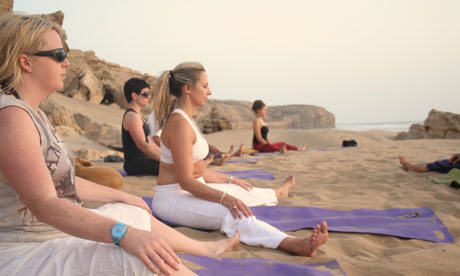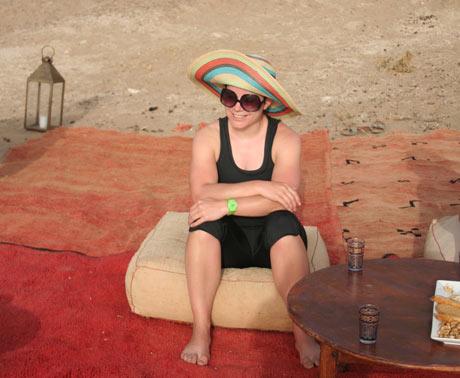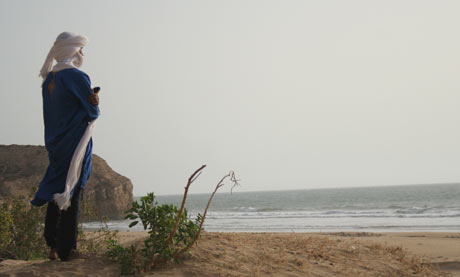Guided by a Tuareg tribe, our writer joins a nomadic retreat on Morocco’s Atlantic coast, walking from beach to beach, practising yoga and sleeping in a camp set up at a different spot each night

At the end of the long day’s walk under the searing Moroccan sun, across endless expanses of sand, the Berbers slowed their camel and stopped. We had arrived at the camp that was to be our home for the night. I was hot and tired after following in the nomads’ footsteps, and desperate to cool off. Lucky for me, we weren’t, as it may sound, in the Sahara desert, we were on the Atlantic coast, so I simply stripped down to my bikini and ran into the sea.
This was the joy of the week I spent on a new “nomadic beach retreat”, walking a stretch of coastline between Essaouira and Agadir with a tribe of Tuareg Berbers. This part of Morocco has mile upon mile of unspoiled, deserted golden sands – we rarely came across anyone save a lone man on a donkey, a pair of horse riders or a local family having a picnic.
In winter the tribe live in the desert, running a luxury camp (desertcampmorocco.com). Their leader, Mohamad Boulfrifri (known as Bobo) turned to tourism when the construction of a dam in Ouarzazate affected his water supply and put paid to his family farm. Bobo has now teamed up with a small company specialising in retreats to offer the unique new beach camp: his tribe take care of the camping and guided walking, and Emma from Morocco Retreats organises yoga, meditation and beauty treatments experienced along the way. It is a far more immersive experience than the usual one-night stay in the Sahara that some tourists stretch too.
Setting up an elaborate Berber camp in the July heat each day looked like hard work but Bobo laughed it off: “We are used to the desert. We love it by the sea! It is cool here!” Bobo, who speaks six languages, was a charming guide with a great sense of humour – and great fashion sense, mixing a batik suit with a modern gilet, or zebra-print shorts with a trendy T-shirt. His tribe operated on a strict hierarchy when there was work to be done but everyone played football together on the beach at break times.
The week began at Riad Zamzam (riadzamzam.com) in Marrakech, an enchanting old fortune-teller’s house in the medina, now converted into a boutique hotel. A small group of us, including a student recovering from exams, a woman with a broken heart and a pair that had stayed at Zamzam before and vowed to return, gathered for some pre-departure pampering. We sunbathed on the roof terrace with views of the dusty city skyline; practised yoga in the riad’s courtyard under a shady palm tree; had an introduction to reiki in the salon; and were scrubbed and pummelled in the hammam.
Beach-ready and already relaxed, we headed west on a three-hour drive to Essaouira, the nearest coastal town to Marrakech, where we lunched atOceanVagabond, a laidback surfers’ hangout. We explored the wind-whipped town’s white and blue port and souk, known for exquisite woodwork and musical instruments – the town hosts the renowned Gnaoua world music festival each year. The bracing wind, which makes Essaouira a surfing hotspot, was a not-entirely-welcome change from the heat of Marrakech. But a short way along the coast, at the village of Sidi Kaouki, where we began our beach walk, the wind had begun to die down.
We would be accompanied by Bobo and the camel on the first walk – the others had gone on ahead to prepare the camp. Tuaregs are traditionally nomadic pastoralists who operated long-distance caravan trading across the Sahara, so it isn’t out of character for them to lead tourists across the sands – albeit far more hospitable sands. I was eager to get going and Bobo had only one instruction: “Follow the camel.”

Rachel relaxes at the beach camp after a day’s walking
We had been walking south along the beach for an hour or two when suddenly Bobo veered off the sand and up a steep, rocky path. After a short climb we emerged on to a flat clifftop with views of the deserted beach and the sparkling silver sea. A handful of luxury tents were grouped around a central area covered in rugs and cushions; a laden dinner table was set to one side. Bobo offered mint tea, gin and tonic or cold white wine, while other members of the clan passed around nibbles. We watched the sun set into the sea before moving to the table, which was illuminated by flaming torches.
Dinner was noisy and fun. As well as six “retreaters” our party included Emma (secretly called Sergeant Major by the Berbers); Rebecca, a reiki practitioner; a yoga teacher and a beauty therapist; and around 16 members of the tribe. After a feast of harira, tagine, couscous and copious wine, histories were shared and stories told. Bobo explained how to navigate by the stars and survive in a sandstorm – two skills that I hoped I wouldn’t need. Sleep came easily that night in our comfortable beds with Egyptian cotton sheets, two to an en-suite tent, lulled by the sound of the waves lapping on the beach below.
I was woken by bleats; a herd of goats had descended on the camp. Hundreds of furry little bodies ambled among us, looking curiously at the human interlopers. When they moved on, it was time for us to do the same. Bobo’s men began to take down the tents as he led us towards the water and onwards. We would be walking for around five hours in total that day.
The beaches were empty until we happened across a popular picnic spot: a fresh water source made it the greenest place for miles around, and locals took their cows there to drink. Waterfalls, lush greenery and grazing cows, in the midst of miles of golden dunes, made the scene appear unreal, like a film set – especially when our camel entered stage left.
We stopped for a breather and I stroked the dog who had been trotting at our heels. I took him for Bobo’s pet but he was a stray who decided to adopt us. Camp Dog, as he became known, followed us everywhere, stayed on guard outside tents as we slept, and even joined in with the yoga; anyone stepping back into downward-facing dog was liable to tread on an actual dog sprawled on their mat.
The walking was wonderful, a sort of active meditation where we could chat, or think, or just empty our minds. The terrain, a mix of beach and clifftop paths, was easygoing aside from the July sun, which became fierce around midday. If it got too much, we could clamber on to the camel for a rest for as long as we liked – a far cry from the strictly-timed camel rides available elsewhere in Morocco.

Our second camp, near the tiny fishing hamlet of Tafedna, was as spectacular as the first. This one was right on the beach – hence my dash into the sea – with a shady lounge tent to escape the heat. We spent two nights here, practising yoga and meditating right on the water’s edge. I read, swam and explored the little caves around the cove. Rebecca gave us a group course in reiki, then individual “healing” sessions. Some got more out of the reiki than others; I found I couldn’t overcome my cynicism, but it was relaxing. Hannan, a beauty therapist from Marrakech, seemed bemused to be working on the beach in the middle of nowhere but her massages were sublime.
Bobo bought fresh fish straight from the boats for our last dinner. The food, cooked by the Berber chefs, was incredible considering the limited facilities. Breakfast might beshakshouka (eggs cooked with tomatoes and peppers) and fruit salad served in a whole watermelon with a lid cut in the top. There would be really fresh salads and brochettes (kebabs) for lunch, and lavish spreads in the evening, featuring lentil and bean dishes, lamb and apricot tagine, and relishes including a particularly delicious sultana chutney.
Our final walk the next day was to be a short inland trek back towards Sidi Kaouki, a nice contrast to the previous days’ coastal strolls, before being picked up by 4x4s and taken back to Marrakech to wash the sand off in a hot shower (not quite as good as a cooling dip in the sea).
But first, there was one last magical night. After the final dinner, we gathered around a campfire to listen to drumming and singing by professional Berber musicians. Eventually, we were all on our feet, dancing to the beats – not quite as elegantly as Bobo and co, perhaps, but just as enthusiastically. They explained each song as they played, ranging from rousing ahwash, village folk music with call-and-response vocals, to slower, sad poem-songs. The musicians, on drums, a flute and a single-string violin, continued playing quietly long after we had gone to bed.
.






